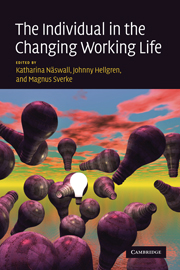Book contents
- Frontmatter
- Contents
- List of figures
- List of tables
- List of cases
- List of contributors
- Acknowledgements
- 1 The individual in the changing working life: introduction
- Part I Threats and challenges
- Part II Individual attempts at restoring the balance
- 12 Skeleton key or siren song: is coping the answer to balancing work and well-being?
- 13 The dynamic influence of individual characteristics on employee well-being: a review of the theory, research, and future directions
- 14 Stress and coping at work: new research trends and their implications for practice
- 15 Work stress, coping, and gender: implications for health and well-being
- 16 The role of protean career attitude during unemployment and re-employment: a literature review and conceptual model
- Part III Intervention and promotion on the organizational level
- Index
- References
13 - The dynamic influence of individual characteristics on employee well-being: a review of the theory, research, and future directions
Published online by Cambridge University Press: 13 October 2009
- Frontmatter
- Contents
- List of figures
- List of tables
- List of cases
- List of contributors
- Acknowledgements
- 1 The individual in the changing working life: introduction
- Part I Threats and challenges
- Part II Individual attempts at restoring the balance
- 12 Skeleton key or siren song: is coping the answer to balancing work and well-being?
- 13 The dynamic influence of individual characteristics on employee well-being: a review of the theory, research, and future directions
- 14 Stress and coping at work: new research trends and their implications for practice
- 15 Work stress, coping, and gender: implications for health and well-being
- 16 The role of protean career attitude during unemployment and re-employment: a literature review and conceptual model
- Part III Intervention and promotion on the organizational level
- Index
- References
Summary
Continuing changes to the nature of work brought on by technological leaps (e.g. Kurland and Bailey, 1999), increasingly diverse workforces, changes to the traditional contractual nature of work (e.g. Barley and Kunda, 2006), and shifting industry demands make it necessary for researchers who study workers and their work environments to consider dynamic relationships at multiple levels within people and work organizations. Employees are consistently being forced to adapt to meet these changing work demands and a potential cost is personal well-being.
Much of this book focuses on how changing work environments and roles can influence the well-being of employees. It is also critically important to attend to the role of individual characteristics in this process. Throughout this chapter the terms “individual characteristics/differences” represent dispositions and more malleable personal qualities. We will provide a conceptual model that integrates many existing findings regarding these issues and offers a set of clear options for future exploration. We encourage readers to think critically about relationships between individual characteristics and well-being in their own research and practice.
This chapter begins with a discussion of the critically important, complex, and yet underdiscussed well-being criterion. Our conceptual framework is presented, followed by a selective review of research on individual characteristics associated with well-being that we feel are particularly relevant in a changing work environment. Finally, we provide a summary and thoughts for future work in this area.
Well-being and the workplace
There is no single, widely applicable theory of well-being.
- Type
- Chapter
- Information
- The Individual in the Changing Working Life , pp. 258 - 283Publisher: Cambridge University PressPrint publication year: 2008
References
- 11
- Cited by

